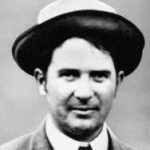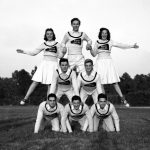state champion

 My niece, Siara Harman is one of many girls who were cheerleaders in high school and college. She even won a State Championship and a Grand National Championship with the Kelly Walsh Cheer Squad in 2011. Since it’s beginnings, cheerleading has come a long way. In fact, I doubt if today’s cheerleaders would recognize their earlier counterparts, if they saw them back then. Siara was a skilled cheerleader, and very athletic, and we are all proud of her cheerleading years.
My niece, Siara Harman is one of many girls who were cheerleaders in high school and college. She even won a State Championship and a Grand National Championship with the Kelly Walsh Cheer Squad in 2011. Since it’s beginnings, cheerleading has come a long way. In fact, I doubt if today’s cheerleaders would recognize their earlier counterparts, if they saw them back then. Siara was a skilled cheerleader, and very athletic, and we are all proud of her cheerleading years.
The roots of American cheerleading are closely tied to American football’s roots. The first intercollegiate football game was played on November 6, 1869, between Princeton University and Rutgers University in New Jersey. By the 1880s, Princeton had formed an pep club. Organized cheering started as an all-male activity, as many sports do. As early as 1877, Princeton University had a Princeton Cheer. Basically, it was a fight song that was documented in the February 22, 1877; March 12, 1880; and November 4, 1881, issues of The Daily Princetonian. This cheer was yelled from the stands by students attending games, as well as by the athletes themselves. The cheer, “Hurrah! Hurrah! Hurrah! Tiger! S-s-s-t! Boom! A-h-h-h!” remains in use with slight modifications today, where it is now referred to as the Locomotive. Princeton class of 1882 graduate Thomas Peebles moved to Minnesota in 1884. He took with him the idea of organized crowds cheering at football games to the University of Minnesota. The term “Cheer Leader” had been used as early as 1897, with Princeton’s football officials having named three students as Cheer Leaders: Thomas, Easton, and Guerin from Princeton’s classes of 1897, 1898, and 1899, respectively, on October 26, 1897. These students would cheer for the team also at football practices, and special cheering sections were designated in the stands for the games themselves for both the home and visiting teams. On November 2, 1898, the University of Minnesota was on a losing streak. A medical student named Johnny Campbell assembled a group to energize the team and the crowd. Johnny picked up a megaphone and rallied the team to victory with the first organized cheer: “Rah, Rah, Rah! Ski-U-Mah! Hoo-Rah! Hoo-Rah! Varsity! Varsity! Minn-e-so-tah!” With that action, Campbell became the first cheerleader in America. Soon after, the University of Minnesota organized a “yell leader” squad of six male students, who still use Campbell’s original cheer today. In 1903, the first cheerleading fraternity, Gamma Sigma, was founded.
In 1923, at the University of Minnesota, women were finally permitted to participate in cheerleading. However, it took time for other schools to follow. In the late 1920s, many school manuals and newspapers that were published still referred to cheerleaders as chap, fellow, and man. Women cheerleaders were overlooked until the 1940s, when collegiate men were drafted for World War II, creating the opportunity for more women to make their way onto sporting event sidelines. As noted by Kieran Scott in Ultimate Cheerleading: “Girls really took over for the first time.” A report written on behalf of cheerleading in 1955 explained that in larger schools, “occasionally boys, as well as, girls are included,” and in smaller schools, “boys can usually find their place in the athletic program, and cheerleading is likely to remain solely a feminine occupation.” During the 1950s, cheerleading in America also increased in popularity. By the 1960s, some began to consider cheerleading too feminine an extracurricular activity for boys, and by the 1970s, girls primarily cheered at public school games. However, this did not stop its growth. Cheerleading could be found at almost every school level across 
 the country, even youth leagues. In 1975, it was estimated by a man named Randy Neil that over 500,000 students actively participated in American cheerleading from grade school to the collegiate level. He also approximated that 95% of cheerleaders within America were female. Since 1973, cheerleaders have started to attend female basketball and other all-female sports as well. As of 2005, overall statistics show around 97% of all modern cheerleading participants are female, although at the collegiate level, cheerleading is co-ed with about 50% of participants being male.
the country, even youth leagues. In 1975, it was estimated by a man named Randy Neil that over 500,000 students actively participated in American cheerleading from grade school to the collegiate level. He also approximated that 95% of cheerleaders within America were female. Since 1973, cheerleaders have started to attend female basketball and other all-female sports as well. As of 2005, overall statistics show around 97% of all modern cheerleading participants are female, although at the collegiate level, cheerleading is co-ed with about 50% of participants being male.

